Cozy Indoors: Overwintering Tips for Healthy Cacti
If you’ve enjoyed watching your cacti thrive during the warm months, you’ll need to make some careful adjustments as winter approaches. While these desert-dwelling plants are surprisingly resilient, they won’t survive harsh winter conditions without proper indoor care. You’ll discover that successfully overwintering cacti isn’t just about bringing them inside—it’s about creating the right environment that mimics their natural dormancy period. Whether you’re nurturing a single Christmas cactus or tending to an extensive collection, understanding these essential winter care strategies will help your prickly friends emerge healthy and vibrant when spring arrives.
Contents
- 1 Light Requirements During Winter Months
- 2 Adjusting Your Watering Schedule
- 3 Optimal Indoor Temperature Settings
- 4 Watch for Signs of Stress
- 5 Managing Indoor Humidity Levels
- 6 Winter Dormancy Explained
- 7 Best Placement Inside Home
- 8 Common Winter Problems
- 9 Protecting Against Cold Drafts
- 10 Seasonal Fertilizing Guidelines
Light Requirements During Winter Months
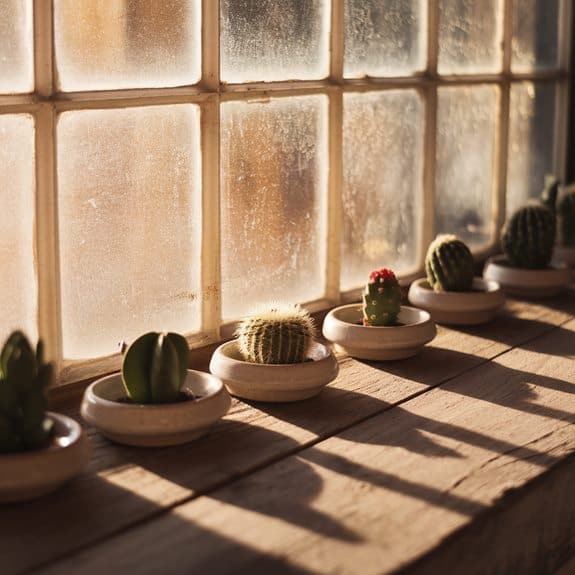
During winter months, cacti need less direct sunlight but still require bright, indirect light to stay healthy. Place your desert companions near south or east-facing windows where they’ll receive 4-6 hours of filtered light daily.
If natural light is limited, you’ll want to supplement with grow lights positioned 6-12 inches above your plants. Just don’t expose them to cold drafts near windows.
Adjusting Your Watering Schedule
Just like reduced light needs, your cacti’s water requirements change markedly in winter. You’ll need to drastically cut back on watering, allowing the soil to dry completely between waterings.
From November to February, water your desert cacti only once every 4-6 weeks. Test the soil with your finger – if it’s still damp two inches down, wait longer before watering again.
Optimal Indoor Temperature Settings
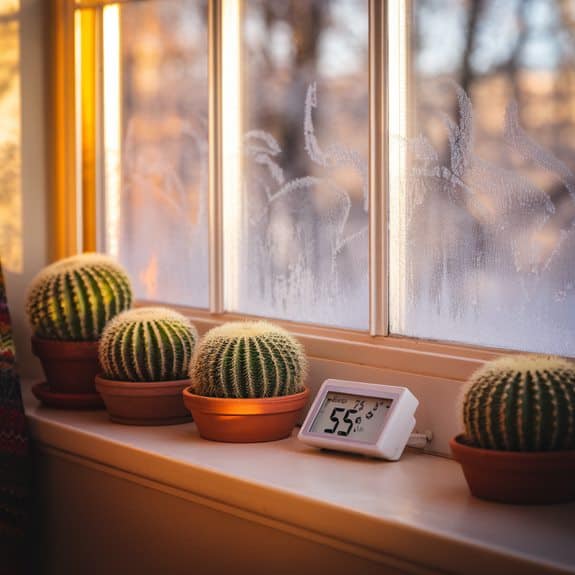
Your indoor cacti need consistent temperatures between 60-65°F during winter days and can tolerate slightly cooler nights around 55-60°F.
You’ll want to keep your plants away from cold drafts near windows, exterior doors, and air vents, which can shock their system and cause damage.
The best placement for overwintering cacti is on an interior shelf or table that’s protected from temperature fluctuations but still receives adequate light.
Temperature Day Vs Night
While overwintering cacti adapt well to indoor environments, they need distinct temperature shifts between day and night to thrive. You’ll want to maintain daytime temperatures between 70-80°F (21-27°C) and let them drop 10-15 degrees at night, ideally to 55-65°F (13-18°C). This temperature fluctuation mimics desert conditions and helps trigger your cacti’s natural growth cycles.
Cold Drafts and Placement
Cold drafts pose a serious threat to overwintering cacti, so proper placement within your home is essential. Keep your plants away from drafty windows, exterior doors, and AC vents.
You’ll want to position them at least 6 inches from windowpanes to protect them from nighttime chills. Don’t place your cacti near heating vents either, as the direct hot air can shock them.
Watch for Signs of Stress
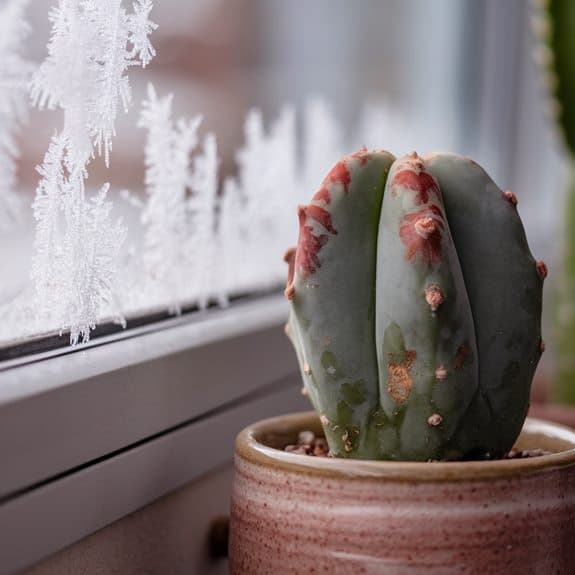
Several key stress indicators can alert you to problems with overwintering cacti. Watch for yellowing, shriveling, or soft spots that signal potential rot.
If your cactus starts leaning or stretching toward light, it’s telling you it needs more sun. Brown patches mean sunburn from sudden exposure, while white fuzzy spots typically indicate mealybugs that thrive in winter conditions.
Managing Indoor Humidity Levels
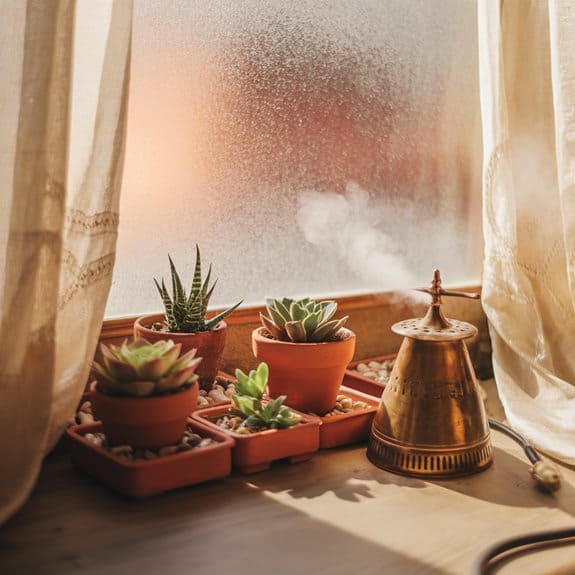
Beyond watching for visible stress signs, maintaining proper humidity around your cacti can prevent many winter problems. Keep indoor humidity between 30-40% for desert species, using a hygrometer to monitor levels.
If your home’s too dry, place a small pebble tray with water near your plants, but never directly underneath. In especially humid rooms, run a dehumidifier to prevent rot.
Winter Dormancy Explained
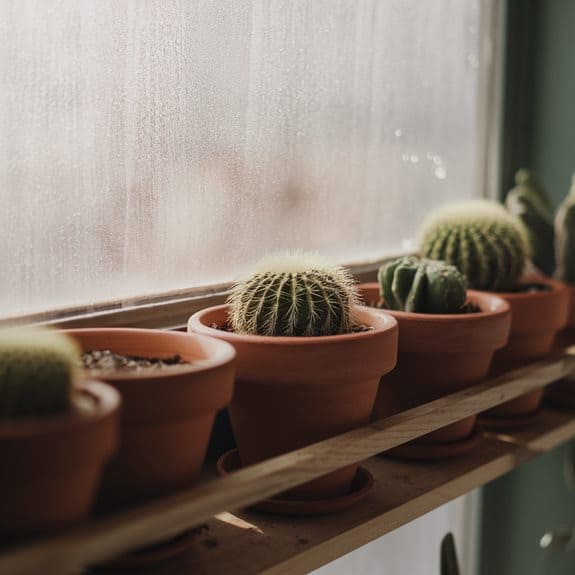
Understanding winter dormancy is essential for cactus care during the colder months. Your cactus naturally slows its growth and metabolism when days get shorter and temperatures drop.
During this rest period, you’ll notice your plant needs less water and nutrients. Don’t worry if it looks a bit shriveled – that’s normal. Your cactus isn’t dying; it’s just conserving energy until spring arrives.
Best Placement Inside Home
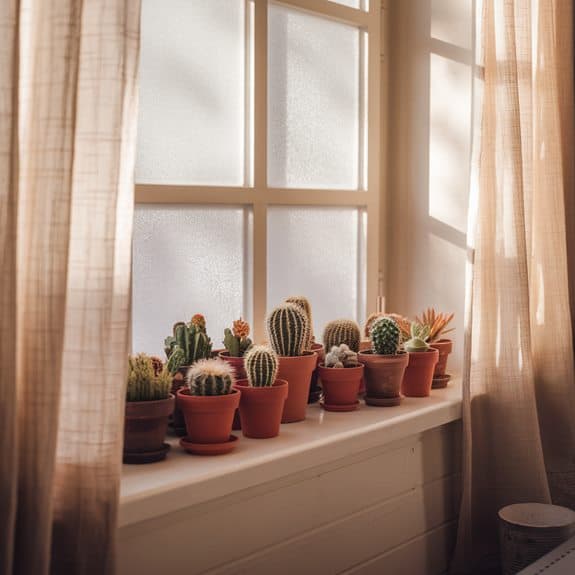
Finding the right spot for your cactus during winter can make the difference between survival and decline. Place your plant near south or west-facing windows where it’ll receive maximum sunlight.
Keep it away from drafty doors, heating vents, and radiators that create temperature fluctuations. A room that stays between 55-65°F is ideal. Don’t let leaves or curtains block its light.
Common Winter Problems
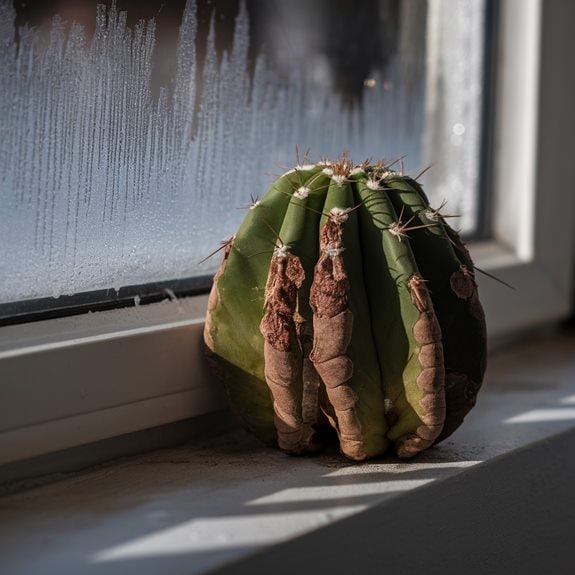
Several problems can plague your cacti during the winter months if you’re not careful. Watch for stem rot from excess moisture, sunburn from sudden exposure to bright light, and frost damage near cold windows.
You’ll also need to guard against mealybugs and spider mites, which thrive in dry indoor conditions. Brown spots and yellowing indicate your plant’s struggling with temperature fluctuations.
Protecting Against Cold Drafts
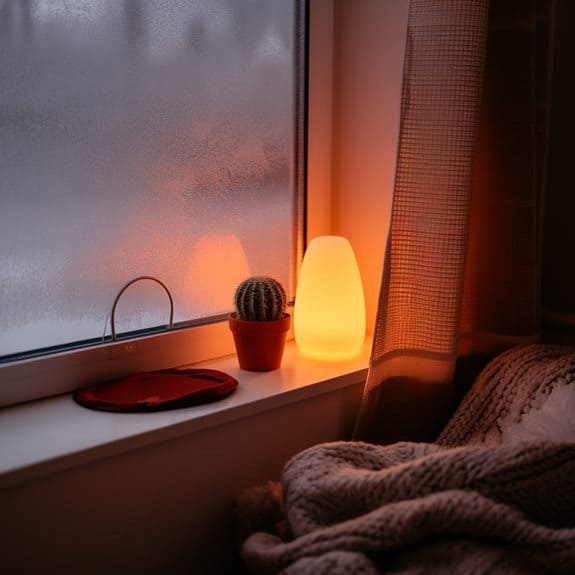
To shield your cacti from harmful winter drafts, you’ll need to focus on weatherproofing windows and doors near your plants with weatherstripping or plastic coverings.
You can further protect your cacti by wrapping their pots with bubble wrap or cloth insulation and placing foam boards underneath to prevent cold from seeping up through the base.
Position your plants strategically by moving them away from drafty areas like entryways, windows, or air vents, ensuring at least a foot of clearance from these cold spots.
Weatherproofing Windows and Doors
During winter months, cold drafts from windows and doors can spell disaster for your indoor cacti. You’ll want to seal any gaps with weatherstripping tape or rubber seals around door frames and window sills.
Install thick curtains or cellular shades to create an extra barrier against the cold. If you’re feeling drafts, use rope caulk to temporarily seal window edges until spring arrives.
Insulating Pots and Bases
Proper pot insulation serves as your cactus’s first line of defense against winter’s chill. Wrap your containers with bubble wrap, foam sheets, or burlap to maintain consistent soil temperatures.
For extra protection, elevate pots on wooden blocks or styrofoam risers to prevent cold from seeping through the base. Don’t forget to secure your insulation with weatherproof tape or natural twine.
Strategic Placement Away Cold
Location plays an essential role in your cacti’s winter survival. Keep your plants away from drafty windows, exterior doors, and air vents that blast cold air.
Don’t place them in unheated sunrooms or garages where temperatures can plummet overnight. Instead, position your cacti near interior walls, at least 6 inches from windows, where they’ll stay cozy and protected from chilling drafts.
Seasonal Fertilizing Guidelines
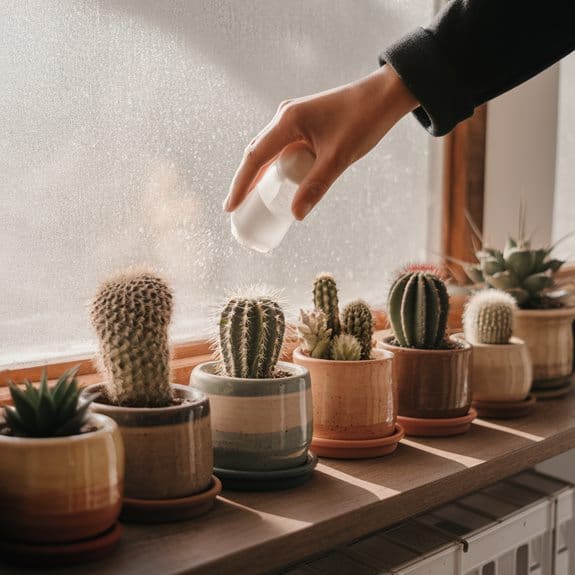
Feeding your cacti requires careful timing throughout the year, with special attention needed during winter months. You’ll want to stop fertilizing completely from late fall through winter, as your plants enter dormancy.
When spring arrives, restart with a diluted, balanced fertilizer every 4-6 weeks. During summer’s peak growth, you can increase feeding to every 3-4 weeks until fall approaches.
